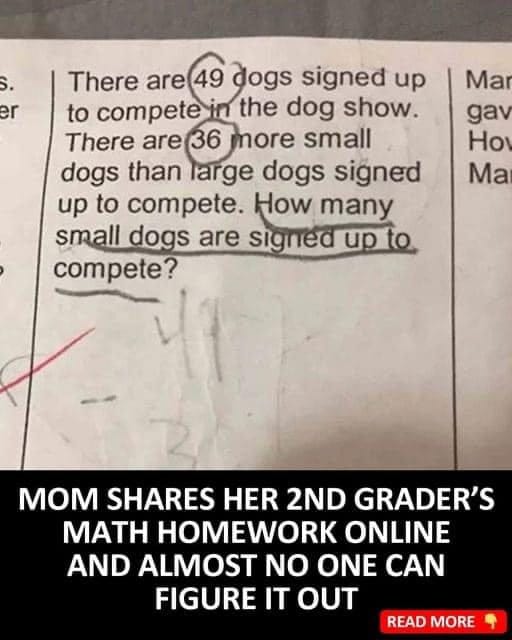
A seemingly straightforward math problem assigned to an 8-year-old student has recently gone viral, leaving many adults perplexed. The question, which involves basic algebra, has sparked widespread discussion online, highlighting how elementary-level problems can sometimes challenge even the most seasoned minds.UNILAD+1The Scottish Sun+1
The Problem That Sparked Confusion
The math question in question is as follows:YouTube+3news+3UNILAD+3
“At a dog show, the number of small dogs is 36 more than the number of large dogs. If there are 49 dogs in total, how many small dogs are there?”
At first glance, this appears to be a simple problem involving basic arithmetic. However, when attempting to solve it, many adults found themselves entangled in the logic, leading to a variety of incorrect answers and a fair share of frustration.
Breaking Down the Math
To solve the problem, let’s denote the number of large dogs as x. According to the problem, the number of small dogs is 36 more than the number of large dogs, which can be represented as x + 36.
The total number of dogs is given as 49. Therefore, we can set up the following equation:
x (large dogs) + (x + 36) (small dogs) = 49 (total dogs)
Simplifying the equation:
x + x + 36 = 49
2x + 36 = 49Multiplication Worksheets |
Subtracting 36 from both sides:
2x = 13
Dividing both sides by 2:
x = 6.5
This result suggests there are 6.5 large dogs, which is not feasible since we can’t have half a dog. This discrepancy is where many adults stumbled, questioning the validity of the problem itself.
Re-evaluating the Problem
The fractional result indicates a potential issue with the problem’s setup. In real-world scenarios, especially involving countable items like dogs, we expect whole numbers. The presence of a fraction suggests that the problem may have been misworded or contains an error.
One possible interpretation is that the problem intended to state that the number of small dogs is three times the number of large dogs, rather than 36 more. If that were the case, the equation would be:
x (large dogs) + 3x (small dogs) = 49
4x = 49
x = 12.25
Again, we encounter a fractional result, which doesn’t resolve the issue.
The Correct Approach
Given the original problem statement, perhaps the intention was to have the number of small dogs be 13 more than the number of large dogs. Let’s test this scenario:
Let x be the number of large dogs, then the number of small dogs would be x + 13.
Total dogs: x + (x + 13) = 49
2x + 13 = 49
2x = 36
x = 18
Therefore, large dogs = 18, small dogs = 31. Total = 49 dogs.
This solution yields whole numbers and satisfies the total count, suggesting that the original problem may have contained a typographical error.
The Importance of Clear Problem Statements
This incident underscores the significance of precise wording in educational materials. Ambiguities or errors in problem statements can lead to confusion, misinterpretation, and frustration among students and adults alike. It’s crucial for educators and content creators to review and verify the accuracy of problems to ensure they convey the intended challenge without unintended complications.
Conclusion
While the math problem assigned to the 8-year-old student was intended to be a simple exercise in basic algebra, its ambiguous wording led to widespread confusion among adults attempting to solve it. This scenario highlights the importance of clarity in educational content and serves as a reminder that even elementary-level problems can pose challenges when not presented accurately.



